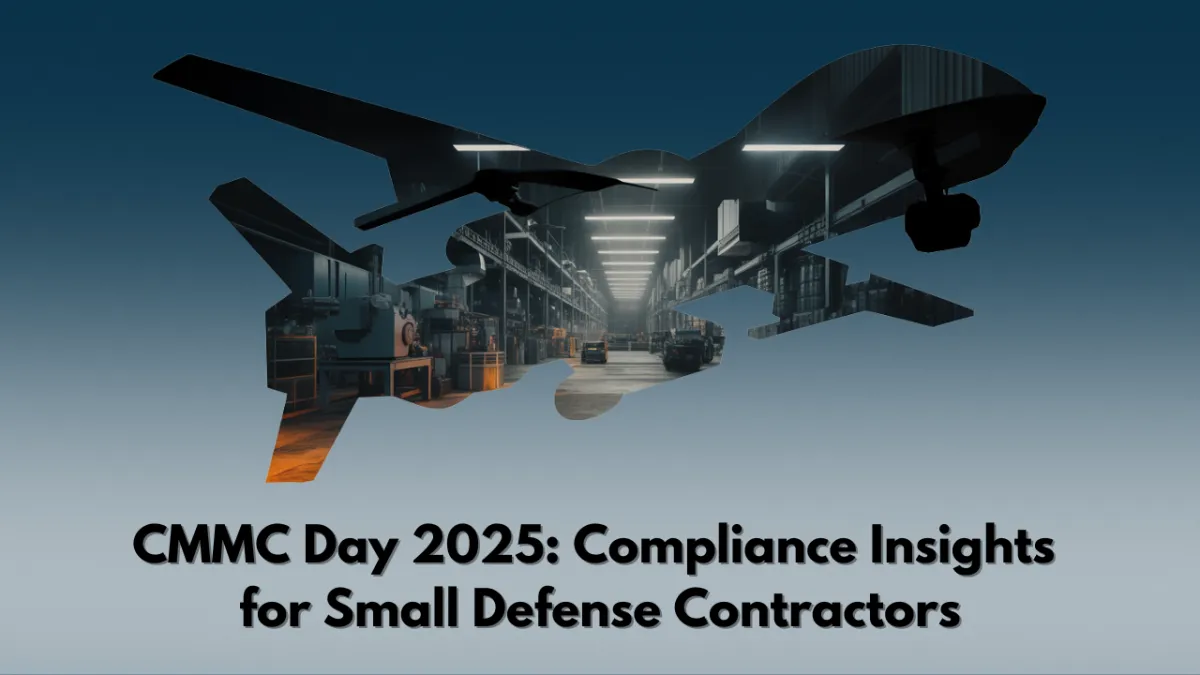
CMMC Day 2025: Key Takeaways and Actionable Steps for Defense Contractors
Why CMMC Day 2025 Matters to Small Businesses
The 2025 CMMC Day in Washington, DC, offered vital updates and clarifications for businesses navigating the ever-evolving world of cybersecurity compliance. For small businesses, these insights are critical to avoid costly mistakes, secure their place in the defense supply chain, and prepare for the accelerating rollout of CMMC requirements.
This article breaks down the most important themes, lessons, and actionable steps discussed during the event, with a focus on small and mid-sized businesses in the defense industrial base (DIB).
Clarity and Commitment to CMMC Rollout
The Train Is Coming – And It's Not Slowing Down
Despite political efforts to derail CMMC, the message at CMMC Day 2025 was clear: the program is moving forward. The light at the end of the tunnel is indeed the CMMC train, and contractors need to get ready now.
Phase Rollouts and the 48 CFR Update
The 48 CFR rule, which will formally require CMMC in contracts, is still pending final review. However, experts expect it to move forward, especially given its direct impact on national defense contracts.
You Can't Hide in the Supply Chain Anymore
Flow-Down Pressure Is Increasing
Primes are applying increasing pressure on their subcontractors to get certified. Subcontractors at all levels will no longer be able to fly under the radar—being part of the defense supply chain means compliance is non-negotiable.
Real-World Stories of IP Theft Underscore the Stakes
Sessions shared sobering examples of intellectual property theft by China, including the cases of Nortel Networks and Motorola. These stories highlighted how failing to protect sensitive data can cripple even the largest companies.
Common Pitfalls Contractors Are Still Making
Mistake 1: Misunderstanding the System Security Plan (SSP)
Many contractors either overcomplicate or oversimplify their SSP. A good SSP should provide a clear, concise, yet detailed overview of how your organization protects CUI, without becoming an 8-mile-long document.
Mistake 2: Poor Scoping Practices
Incorrect scoping—either making the scope too wide or too narrow—remains a major issue. Companies must carefully define and control their CUI environments to avoid unintended scope expansion during assessments.
Mistake 3: Overlooking Access Control Fundamentals
Confusing identity with authorization is a frequent mistake. Contractors must maintain an explicit list of who is authorized to access CUI, including employees, contractors, and even devices like printers and scanners.
Scoping and Data Flow: The Foundation of Compliance
Mapping Your CUI Data Flows
Successful CMMC preparation starts with understanding what CUI you have, where it comes from, where it goes, and how it's handled at every point—including physical documents and alternate worksites.
Surveys and Staff Input: Uncover Hidden Gaps
A simple but effective strategy is sending out CUI surveys to key staff to uncover blind spots in data handling practices.
Tools and Technology: Avoiding Common Traps
GCC vs GCC High: Why the Safer Path Is GCC High
Microsoft 365 GCC High remains the preferred and safest environment for handling CUI due to its FedRAMP authorization and alignment with CMMC requirements—despite its higher costs.
Zero Trust: More Than a Buzzword
Zero Trust principles, while complex, are one of the most effective ways to enforce least privilege access and reduce cybersecurity risks.
Endpoint Protection: Don't Overlook Security Protection Data (SPD)
Endpoint protection tools must also be considered in scope if managed via the cloud, as they process sensitive security data.
Industry Buzz: Beyond Sessions and Keynotes
DIY vs Hiring Expertise
A common topic of hallway conversations was the hidden cost of trying to manage CMMC in-house without dedicated expertise. Many businesses underestimate the complexity and end up needing outside help—either through hiring or contracting with experienced providers.
The Bigger Picture: National Security and Economic Impact
The theft of intellectual property by nation-states like China is not just a business risk—it’s a national security issue. This urgency is driving CMMC forward, regardless of industry skepticism.
Actionable Next Steps for Defense Contractors
Start at the Beginning
Map your CUI data flows, identify your data types, and define your scope carefully.Review Your Documentation
Ensure your SSP and other documents are clear, accurate, and reflect your actual processes.Engage Certified Professionals
Work with Registered Practitioners (RP), Certified Professionals (CCP), or Certified Assessors (CCA) to validate your approach and avoid missteps.Prepare for the Future
Even if you’ve already started the compliance journey, take the time to step back, reassess your scope, and validate that your documentation still matches your current operations.
Conclusion: Don't Wait for Compliance Deadlines to Act
The message from CMMC Day 2025 is clear—compliance is no longer optional, and the consequences of inaction can be catastrophic, both for your business and national security. Small businesses in the defense supply chain need to act now, starting with the fundamentals of scoping and data mapping.
If you need a guided roadmap, consider taking advantage of free resources like our SPRS 110 score roadmap session. No pitch, no pressure, just expert help.
